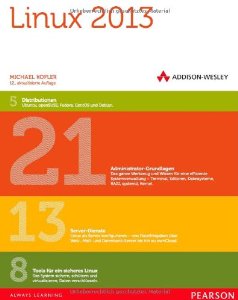New book Koflera. Linux Installation, configuration, administration

Original Title : Linux 2013
Author : M. Kofler
Translation of the book : O. Sivchenko
Release date : September 2013
In the fall we have a new book by the famous Linux guru Michael Kofler.
')
Annotation:
Linux along with Microsoft Windows and Apple OS X is one of the most important operating systems for PCs. Linux systems are installed on many large servers (in particular, Google and Amazon use Linux). Linux is used on numerous Android-based smartphones and tablets, as well as embedded systems (firmware for devices that are not at all like computers? - for example, ADSL modems, WLAN routers and NAS hard drives).
Many users who are not told by the name “Linux” already use this operating system in one form or another. Previously, there were prejudices that Linux was supposedly too complicated and inconvenient to use, but today they are overcome. Of course, Linux does not work exactly like Windows, but switching from Windows to Linux is no more difficult than from Windows 7 to Windows 8. At the same time, most Linux distributions are free and significantly more reliable than Windows. Linux also does not get viruses and trojans.
But if Linux is so easy to use, why write such a thick book about it? There are several reasons for this:
Linux is not just an alternative operating system that can replace Windows with a PC. Linux has numerous advanced features and functions. We can talk about how to automate everyday tasks, and about many other things, up to the configuration of network servers. Today, almost any user knows how to handle browsers, email and office programs, but other topics, more complex from a technical point of view, required a more detailed description.
Linux is not a single operating system, but many different distributions. A distribution is a set of programs designed to work in Linux. The most famous distributions are Debian, Red Hat, openSUSE and Ubuntu. Such diversity is in many respects a blessing, but there is an obvious drawback: many of the details in different distributions are implemented differently. The author tried to build this book in a universal key, without being tied to specific distributions. Nevertheless, remarks like this happen every now and then: “in openSUSE it works like this, in Debian and other distributions it is different.”
This book is designed to teach the reader not only to work with Linux, but also to understand it. Therefore, the book is not a simple collection of screenshots with directions like “click here”. The author considers it his most important task to explain the basics of Linux and introduce you to the basics of the philosophy of Linux / Unix.
Let's learn how to do in Linux!
Brief table of contents of the book:
Chapter 1. A quick introduction to Linux
Chapter 2. Gnome
Chapter 3. KDE
Chapter 4. VirtualBox4
Chapter 5. Terminal windows and console operation
Chapter 6. Bash (Shell)
Chapter 7. File Management
Chapter 8. Process Management
Chapter 9. Graphic, audio and text file converter
Chapter 10. Networking Tools
Chapter 11. Basic Configuration
Chapter 12. Program and Package Management
Chapter 13. Libraries, Java and Mono
Chapter 14. File System Administration
Chapter 15. GRUB
Chapter 16. Init System
Chapter 17. Kernel and Modules
Chapter 18. Network Configuration
Chapter 19. Internet Gateway
Chapter 20. Samba
Chapter 21. NFS and AFP
Chapter 22 SSH (Secure Shell)
Chapter 23. Apache
Chapter 24. MySQL
Chapter 25. Backup
Chapter 26. Firewalls
Chapter 27. Virtual Private Networks
Chapter 28. Squid and DansGuardian (network filter)
Chapter 29 SELinux and AppArmor
Source: https://habr.com/ru/post/187672/
All Articles